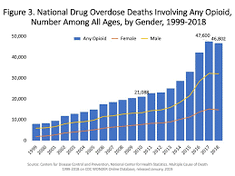|
Opioids have been used since the 1860s to treat soldiers in the Civil War. Substances such as morphine were commonly used in the 20th century to provide relief for patients with cancer and deadly diseases. It was strictly regulated and only given when absolutely needed. However in 1998, a new family company by the name of Perdue Pharmaceuticals invested $207 million (2) on marketing their new revolutionary product: Oxycontin. Deemed the “Miracle Drug”, oxycontin was prescribed to patients with severe and chronic pain. As sales continued to soar, so did the production of the drug. More and more doctors started to prescribe it to patients. Does this mean that the doctors didn’t have proper guidance in their use or that they simply didn’t provide them to the patients -- it’s an important distinction! As a Perdue Pharma memo stated, “Your priority is to Sell, Sell, Sell OxyContin” (3). As Perdue aimed to end the chronic pain epidemic, they in turn started a chain of events that would begin a new epidemic, The Opioid Epidemic.
Today, there are over 142 deaths related to overdose (1). In comparison, every three weeks we have a loss equal to the loss we had on 9/11. Treatments such as naloxone are only given to recover an overdose patient but not permanently heal them from their addiction. State governments must step up and understand that this is a serious issue. As a community, we need to advocate for more employees for drug addiction centers and place a strong mandate on drug prescriptions. To contribute individually, you should be aware of your prescription and make sure you spread awareness. Opioids are one of humankind’s greatest assets, only if used properly. Citations
Comments are closed.
|
|

